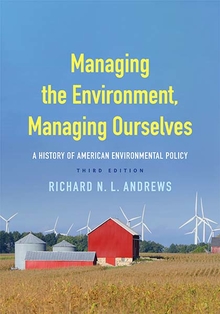Book Release: “Managing the Environment, Managing Ourselves, 3rd Edition, A History of American Environmental Policy” by Richard N. L. Andrews (’70, ’72)
March 16, 2020
In a new book to be released Mar. 17 by Yale University Press, Richard N. L. “Pete” Andrews examines the 50-year history of the modern environmental policy era against the background of the four centuries of American environmental policies that led to it. In this revised and updated third edition, Managing the Environment, Managing Ourselves: A History of American Environmental Policy delves deeper into the history of the agencies, presidential administrations and policies that shaped the environmental landscape of today.
As Americans this year celebrate the 50th anniversary of Earth Day, the creation of the U.S. EPA and the beginning of the modern environmental policy era, Andrews details the events and history that led us to our current state, including a chapter on the current presidential administration.
“This is the only book that provides a really detailed history of American environmental policy,” says Andrews. “It looks at the policies of the last 50 years, beginning with the decade in which the modern statutes of American environmental policy were written, against the background of the previous 400 years – when we had environmental policies, even if we didn’t call them that – that created the conditions that called forth the more modern policies.”
Andrews was inspired to write the book when he was working on an early study of the National Environmental Policy Act, and was challenged by a respected colleague to investigate why the federal agencies whom environmental advocates considered “villains” thought that pursuing their historical missions was the right thing to do.
“That sent me off on a career-long quest to understand the historical background of environmental problems,” Andrews says. “They didn’t just come out of thin air; they came out of previous policies, and out of earlier social and economic forces.”
The first edition was released in 1999 and updated in 2006. The latest edition is updated through the Obama and Trump administrations and also goes into greater detail on the policies of the modern era.
“This time I decided that too much had happened to simply add onto the previous edition, and I also wanted to address more of the details of the modern environmental policy era than I had in previous editions,” Andrews says. “The first two editions focused mainly on the policies of each of the modern presidencies, but that’s just part of the story. You really need to understand each of the 4 or 5 domains of environmental policy and the agencies that affect them – pollution policy and the EPA, public lands and wildlife and the Interior Department, agricultural and urban environmental policy, the role of energy policy as environmental policy, and the U.S. role in international environmental policymaking—so I put a lot of thought into reorganizing and enriching the details of the modern policies.”
Yale University Press markets the book as a textbook, and it is used in courses around the country.
“But it isn’t written just for students and scholars,” Andrews says. “It really is written as a book that will appeal to anyone who is seriously interested in the environmental policy issues today and where they come from. It’s written for people who work as environmental professionals, for activists in environmental organizations, and really for any interested citizens who care about the environment, whether they consider themselves liberals or conservatives. It has a lot of detail and a historical perspective that you won’t find anywhere else.”
The last two chapters deal with the past two years and the question of whether the election of Donald Trump and his administration signifies the end of the modern environmental era and the beginning of a more conservative one, or merely a brief interruption. Previous conservative presidents such as Ronald Reagan and George W. Bush tried to roll back environmental policies, but ultimately signed important environmental laws and left more moderate legacies. The final chapter highlights some of the most significant environmental issues that policies have not yet solved and also points to examples of promising initiatives by states, businesses, and citizen groups in response to the recent absence of federal leadership.
“Regardless of who the president is, there are signs of hope in state, business, and grass-roots citizen initiatives,” Andrews says. “The tragedy of recent environmental policy at the national level is that it has become hostage to a larger ideological battle over big versus small government and the role of federal regulation. In reality, environmental issues need not and should not be partisan—there are many conservative environmentalists as well as liberal ones, and more than a few red-state governors who are promoting wind and solar energy. And some of the most effective environmental policy tools are market-oriented incentives – conservative solutions – not just regulations if we can just reaffirm enough shared commitment and trust to create effective solutions rather than just score partisan ideological points.”
Andrews is professor emeritus of environmental policy at the University of North Carolina at Chapel Hill and a faculty fellow of the UNC Institute for the Environment. He has written, taught, and advised on U.S. environmental policy for fifty years and has served on multiple national environmental policy committees. Andrews earned his undergraduate degree in philosophy from Yale University and his master of regional planning and doctor of philosophy in environmental policy and planning from the University of North Carolina at Chapel Hill.
This book is published by Yale University Press. Copies are available online and at the Bull’s Head Book Shop.
